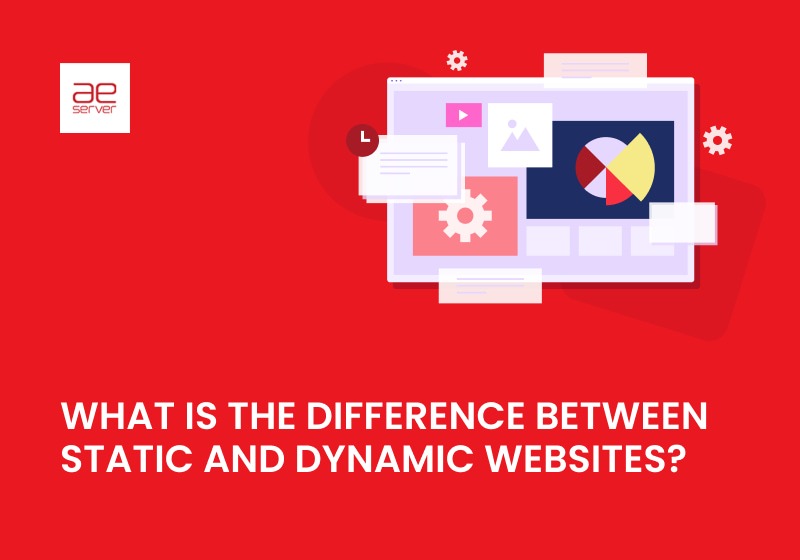In today’s digital world, the Internet is a vast canvas. And on it, companies and individuals paint their online presence. When creating this virtual masterpiece, two different approaches can be distinguished. These are static website development and dynamic. Each has a unique plan, design philosophy, and purpose.
Static websites are eternal, elegant monuments of the online world. They resemble classical sculptures frozen in time. They have an unchanging look, and the creators don’t intentionally update it. It’s as if they capture a moment in the history of the Internet. And offer a snapshot of information for all to see.
On the other hand, dynamic web developments are living creatures of the digital world. They evolve, adapt, and respond to user interaction. These sites are the driving force behind e-commerce, social networking, and other interactive opportunities. They make the Internet a dynamic, ever-changing ecosystem.
Let’s delve into the intricacies of these two web development philosophies. We’ll shed light on their advantages and disadvantages. Welcome to the dynamic world of static and dynamic websites!



Table of Contents
Static Websites
A static website is a fundamental and simple form of web content. And such sites you can not rarely find on the Internet. Static websites should already cease to exist. It is all because it is not suitable for our modern environment. But in fact, such sites are the basis and classics. They are simple; they are easy to load. And that’s why many people appreciate them, especially the older generation. Because they will not find a variety of flying objects in this type of site. Usually, people use these sites for personal blogs, small businesses, and portfolios. These sites are easy to create and require minimal server resources. It makes them a practical choice for those who prioritize simplicity and performance. Of course, static website development lacks interactivity and real-time content updates. But they have stability and low maintenance requirements. And that’s beneficial for certain purposes. They provide a reliable way to share information without complex databases.Definition and Characteristics
It is a type of web platform with unchanging content and fixed design. The difference between static and dynamic websites is that these sites display specific web pages. They remain unchanged until the developer or site administrator changes them. To create these websites, developers usually use:- HTML
- CSS
- Sometimes JavaScript
Advantages
Static websites offer several advantages. They make them the preferred choice for specific web development scenarios: Speed. Static websites are incredibly fast. They provide users directly with pre-rendered HTML pages. There is no server-side processing required. It ensures that pages load almost instantly. Security. This website has simplicity and no server-side scripting. Therefore, static websites are less vulnerable to security breaches. They are also less likely to hack attempts as compared to dynamic websites. Reliability. Static website development has a high level of reliability. This is because their content remains unchanged until updated. The risk of unforeseen errors or problems is minimal. Cost-effectiveness. The placement of such sites is economically advantageous. They require fewer server resources. And you can host them on inexpensive hosting plans. Or you can host them on content delivery networks (CDNs). SEO-friendliness. Search engines favor static sites for their speed and simplicity. They are often easier to optimize for search engine rankings. It is especially easier compared to complex dynamic sites. Scalability. The difference between static and dynamic websites is that they can withstand high loads without significant performance degradation because they do not depend on server-side processing. Ease of maintenance. Maintaining static websites does not require much effort. It consists of simply updating HTML and CSS files. There is no need for complex content management systems (CMS) or databases. Static websites are generally a great choice for projects where simplicity is important. And also for those who need speed and reliability.Limitations
Yes, static websites have many advantages. However, they also have several limitations that dynamic websites do not have. These may make them unsuitable for use in some cases: Lack of interactivity. Static websites are not designed to be interactive. They are less suitable for dynamic applications. For example, it’s not good for social media platforms or e-commerce sites. Updating content. Changing the content of static sites requires manual editing of HTML files. It can be time-consuming and error-prone on large sites. Content changes may not be immediately displayed to users. Limited functionality. Static websites may not be able to handle complex functions such as:- User authentication
- Database integration
- Providing personalized content

Dynamic Websites
Many people wonder what is the difference between static and dynamic websites. The answer actually lies on the surface. The very names of websites already suggest the answer. With a static website, we have already dealt with it. Now, it’s time to deal with dynamic web development. As with the first website, a dynamic website tells us its meaning. It is a web platform that generates and displays content on the fly. It responds to user interaction, data input, and other external factors. Unlike static sites, dynamic sites are highly flexible and interactive. They can adapt their content and functionality in real time. The dynamic nature of such sites allows them to be used in applications such as:- Social media platforms
- E-commerce stores
- Content Management Systems (CMS)
- Forums
- In any scenario where content needs to respond to user actions.
H3: Definition and Characteristics
Dynamic websites are web platforms that can generate and deliver content on the fly. They can adapt in real-time to user interaction and input. Unlike static websites, these utilize server-side scripting languages such as:- PHP
- Python
- Ruby
- JavaScript (Node.js)
Advantages
Dynamic websites have a number of advantages. These are what make them suitable for a wide range of web applications: Interactivity. Dynamic sites allow for user engagement. It is thanks to interactive features. The interactive features enhance the user experience. Real-time updating. You can update content instantly. It will ensure users have constant access to the latest information and data. Personalization. Unlike static website development, dynamic ones can provide personalized content. It happens due to the preferences and behavior of users. It increases their engagement and satisfaction. Comprehensive functionality. This type of website can support a wide range of functions. It makes it versatile For different business needs. Effective content management. You can effectively manage your content with a content management system. It allows multiple contributors to easily update and publish content. Database integration. With dynamic websites, you can integrate with databases. This makes them suitable for applications that depend on data storage and retrieval. Scalability. This type of website can handle a high traffic load. It can handle a growing user base by efficiently utilizing server resources. These advantages make dynamic web development particularly well-suited for applications. They are also suitable for web applications that require interaction.Limitations
Thinking about what is the difference between static and dynamic websites, you should not forget that dynamic also has disadvantages. And some limitations you should consider before you start making this type of site: Development complexity. Creating and maintaining dynamic websites can be a more complex and time-consuming process. All because they need to use server-side scripts and databases. Higher costs. This type of website requires more resources. It includes hosting, database support, and ongoing maintenance. It can lead to higher costs. Performance. Complex data processing can slow down the loading of the site. It negatively affects the user experience. Especially if you have not customized your website properly. Security risks. Dynamic web development can be more vulnerable to security threats. It requires vigilant security measures and regular updates. Maintenance. If you want to ensure the functionality and Security of your website, then you need regular maintenance. It can be time-consuming and costly. Scalability issues. Dealing with sudden spikes in traffic can be difficult. It is difficult for sites that do not have proper scalability measures in place. Search Engine Optimization (SEO). Dynamic websites may require additional SEO optimization efforts. It is because of the dynamic content and URL structure. Despite these limitations, dynamic websites remain an effective choice for applications. Careful planning and development can help reduce these problems. You will be able to effectively utilize the benefits of dynamic websites.Choosing Between Static and Dynamic
So, now you know the difference between static and dynamic websites. But which one should you choose? The choice depends on the specific goals and requirements of the project. To make an informed decision, you need to consider the following factors: Static websites are suitable in the following cases: Simplicity is key. Do you need a simple web presence with minimal interactivity and updates? Static websites are a cost-effective and efficient choice. Performance matters. Static websites offer faster load times. They are ideal for content-oriented websites. That’s where speed is critical. Limited resources. Don’t have much technical knowledge, time, or budget to develop a website? Then, static websites are easier to manage. Dynamic web development are preferable when: Interactivity is Essential. Are you developing an application where you need accounts, comments, and so on? Dynamic websites provide the necessary features. Frequent content updates. Do you need to change content frequently or an easy-to-use content management system? Then, it’s better to use dynamic sites. Complex functionality. Do you need features such as user authentication or e-commerce? Dynamic websites provide the flexibility you need. Ultimately, the choice depends on your unique needs. It’s also important to consider your budget and long-term project goals. Many websites also use a combination of static and dynamic elements. This way, they can find a balance between simplicity and functionality.Factors to Consider
When deciding between static and dynamic websites, consider factors like: Interactivity. Determine if your website needs user accounts, forms, or real-time updates. Content Updates. Assess how often your content will change and if you need a content management system. Complex Functionality. Consider features like e-commerce, databases, or custom applications. Performance. Evaluate the need for fast loading times and responsive design. Budget. Analyze your financial resources for development, hosting, and maintenance. Technical Expertise. Assess your team’s skills or availability for managing the website. Security. Consider the level of security required for your data and user information. Scalability. Plan for accommodating future growth in traffic or functionality. SEO. Think about your strategy for optimizing search engine rankings. Long-Term Goals. Align your choice with your website’s future expansion and development needs.Conclusion
We hope our article helped you understand the difference between static and dynamic websites. Do you want to host dynamic websites? Then AEserver is the perfect choice for you. This reputable hosting provider is known for its reliable infrastructure and excellent customer support. Our services allow us to provide reliable hosting for dynamic websites. We guarantee your optimal performance and security. Ultimately, the choice should match your project’s unique needs, budget, and long-term goals. You should choose a reliable hosting provider to ensure the success of your website. AEserver looks forward to working with you.FAQ
Is there a meaningful difference between static and dynamic websites?
Yes, static websites are always fixed. And dynamic websites adapt to user interactions and data inputs.
Can I combine static and dynamic web development?
Yes, combining both elements allows for a balance between simplicity and interactive functionality.
How do I choose the type of website I want?
Choose based on needs: static for simplicity, speed. Dynamic is for interactivity, updates, and complex functionality.





